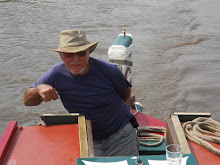I had volunteered to take the Narrow Boat Trust pair to the Reading Water Festival with Barry Adams, who has been one of my mentors when working these historic boats. http://www.narrowboattrust.org.uk/index.html
Unfortunately, the River Kennet was in flood and the festival was cancelled at the last minute, due to the high water levels. However, Barry and I decided to go to the boats moored at Burghfield to do a few jobs on board; Barry having acquired a temperature gauge, which he wanted to fit to the engine. This we did on the Thursday, using only the basic tools on board, which meant reaming out a round hole with a square file and no vise to hand. By the time this job was finished, it was too late to shop and cook, so we repaired to the pub for a meal and beer.
The following day, Barry was anxious to try out the gauge to see if it did the job and to assess the temperature of the engine coolant, having cleaned out the water system previously to try and cure the overheating problem The water level had dropped overnight by about two inches. I reversed the boat into the stream and we made slow headway through the next bridge ‘ole against the current. Several other boats had also travelled upstream before us and did not appear to have any problems, except for slow progress. All went well apart from me having difficulty getting round some of the sharp bends in one go. We reached Tyle Mill and I winded the boat bow first into the weir stream, which turned it very quickly and then reversed up to a mooring, where we stopped for a light lunch.
The return journey went well and was much faster than when coming up, apart from two of the locks, which slowed us down due to them being the same length as the boat, when below cill level.
 |
| Barry Tightens the Top Strings |
We had had no problem coming up stream, because the stem was lifted over the top cill, but the boat barely fitted between the top cill and the bottom gates when the lock was empty and going downhill. If the boat was fitted diagonally, it was impossible to get out with the bow tucked in behind the closed gate. The only way was for Barry to take the bow line and position the stem between the mitre of the two gates. At this point, the rudder was at right angles to the cill and hard against it, but Barry was then able to open a gate to get the boat out. It became obvious that these locks were not built to take boats of 71ft in length, and a breasted pair would have to single out. On the other hand, some locks were much longer than the boat and would easily take two boats.
 |
| A Tight Fit! |
The entrance to the weir stream where we were moored was at an acute angle to the way we were travelling, which entailed carrying on until a winding hole could be found to turn the boat round. Although there were several marked in the Nicholson’s Guide, they were into fast flowing weir streams and impossible to navigate.
 |
| "Where is that winding 'ole?" |
Eventually, after a couple of miles there was one marked above Fobney Lock, which was also into a weir stream, but the width reduced the flow of water considerably. Even though it was wide, the stern was into a tree. Barry boarded the boat after walking for a fair distance from the last lock and we returned to the Burghfield mooring for a pub meal and welcome drinks with Keith, the present NBT chairman.
Finally, the temperature gauge was pronounced a success, but indicated that the engine was now running at 50 to 60 degrees instead of 70 to 80, which would be expected, so there is still more work to be done.

No comments:
Post a Comment